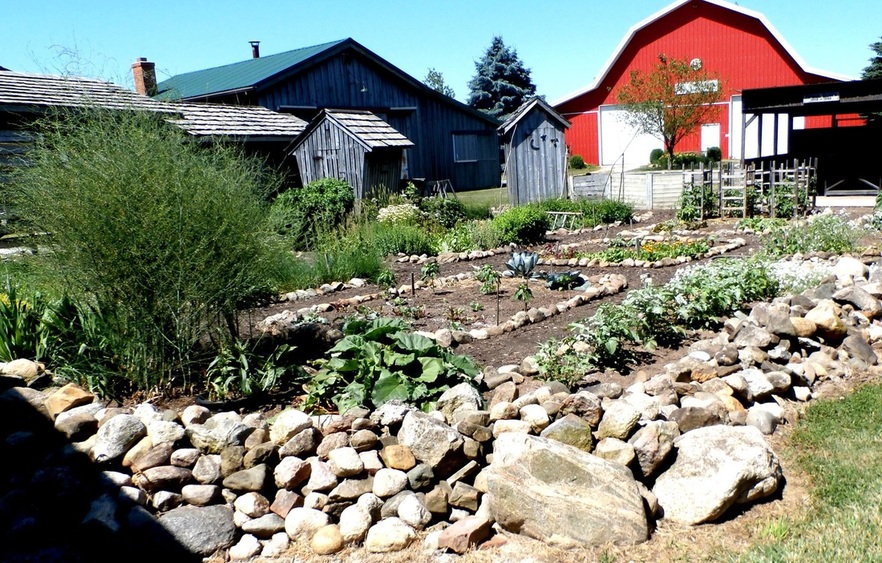Pioneer Heritage Garden at the La Porte County Fair

The Pioneer Land Log Cabin Committee planted the original heirloom garden in 1997 and maintained it until 1998. In 1998, the La Porte County Master Gardeners modified the garden based on a four-square kitchen garden plan, which they constructed and planted in 1999. The two beds at the west end were added in 2002. The garden has been modified and enlarged several times over the years. After many hours of research, Master Gardeners made every effort to plant an heirloom garden that was as historically accurate as possible.
This Pioneer Heritage Garden represents a living history of herbs and vegetables as they would have existed circa 1850-1880. It is a “sampler” that reflects some of the most commonly used cooking, medicinal, and household herbs and vegetables dating to the mid-1800s. The garden is based on a Four-Square Kitchen Garden Plan, which was popular during that period because it was an efficient means of feeding a household. The soil could be amended (improved) and vegetables could be planted more densely. Borders, hedges or a fence provided protection from destructive animals.
Gardens were very important in the lives of pioneers who settled Indiana and the Midwest. Land was usually cleared in a matter of days after settling a new location. Believing that wide prairies were infertile and that growth of hardwood trees indicated rich soil, settlers increased their chores by clearing wooded areas. They chopped down 8-10 acres of trees and stumps annually. Within that cleared parcel, a small plot, 10-sq. ft. to 1/4 acre or more, was devoted solely to garden vegetables to feed households. In time, especially as pioneers prospered and families grew in size, so did their gardens.
When immigrants came from other countries, they brought seeds and plants with them because they did not know what they would find in the new land. Women sewed packets of seeds in the hems of their dresses and in the brims of their hats and tucked tiny plants in their pockets and in the baggage they brought aboard ships so these items would not be taken away when they arrived in this country.
What did Hoosiers grow? Most Hoosiers did not record garden information and gave many vegetables local names. These varieties were named and preserved within families and communities. In the 1800s, when Shakers began packaging and selling seeds, they renamed varieties. So, we have to turn to seed catalogs and garden literature of the period to determine varieties of plants available and how they were cultivated. It is a difficult task because dealers also changed variety names and did not illustrate them. This common practice in the 1800s provided novelty to their seed offerings to increase sales.
The forms and contents of Hoosier gardens varied with personal choices influenced by many things including the nationality of the gardeners themselves, previous gardening experiences, cost, and availability of seeds and plants. Pioneers saved seeds for next year’s planting and traded with friends and neighbors hoping to find new varieties that might improve crops. Transportation was poor or under-developed, except near large cities, so kitchen gardens had to supply families with sufficient supplies to see them through the winter months.
The most commonly used storage methods were drying, salting or pickling. Pioneers relied on livestock, game, and fish to supplement their diet.
Pioneers also faced annoying bugs and pests as we do today. They did not have modern pesticides so they used various methods to control or destroy insects. For example, to deter insects they poured very hot and then cold water on plants or they placed sage leaves around infested plants. They also laid cabbage leaves between plants to attract slugs and snails to the leaves, then collected and burned the leaves in the morning. Onion skins controlled squash bugs and strong soapy water thrown on plants killed some insects.
As the influence of ornamental gardening moved westward, flower beds, borders, and flowering shrubs began to appear in gardens. Women paid more attention to the decorative, ornamental, and pleasurable aspects of their gardens and so they planted flowers to liven them up. These flowers attracted bees to pollinate vegetables and to provide honey to sweeten recipes, as well as bee’s wax for making candles. Pioneer women also dried flowers to provide beauty indoors during long dreary winter months.
Every garden included herbs that were used fresh or harvested and hung to dry for use during winter. They used herbs in cooking just as we do today. More importantly, herbs provided medicinal cures. Pioneer women knew how to concoct salves for burns and cuts or could brew teas for headaches and other ailments. They used some herbs as cosmetics for skin and hair; others for cleansing creams, astringents, and fragrances to scent the house and linens. They used other herb plants in households to discourage vermin and insects, stuff mattresses and pillows, or to dye fabrics.
Many early pioneer women made their own special concoctions for seasoning, soothing, and salves from the plants in their kitchen gardens. Recipes were handed down from mothers to daughters and shared in daily gossip and became a significant part of their daily lives. In time, women accumulated a wealth of knowledge about herbs and their many uses.
Herbs came from various places. Some were easily gathered in the wild and planted in gardens. Others were brought aboard ships with immigrants. When families moved westward they took these plants with them and nurtured them until they took root in the new land. On their journeys, women gathered plants native to different regions and learned their uses from Native Americans and earlier settlers. They swapped information on new herbs and their uses with friends and neighbors. Consequently, the pioneer gardens became quite a collection of diverse plants.
